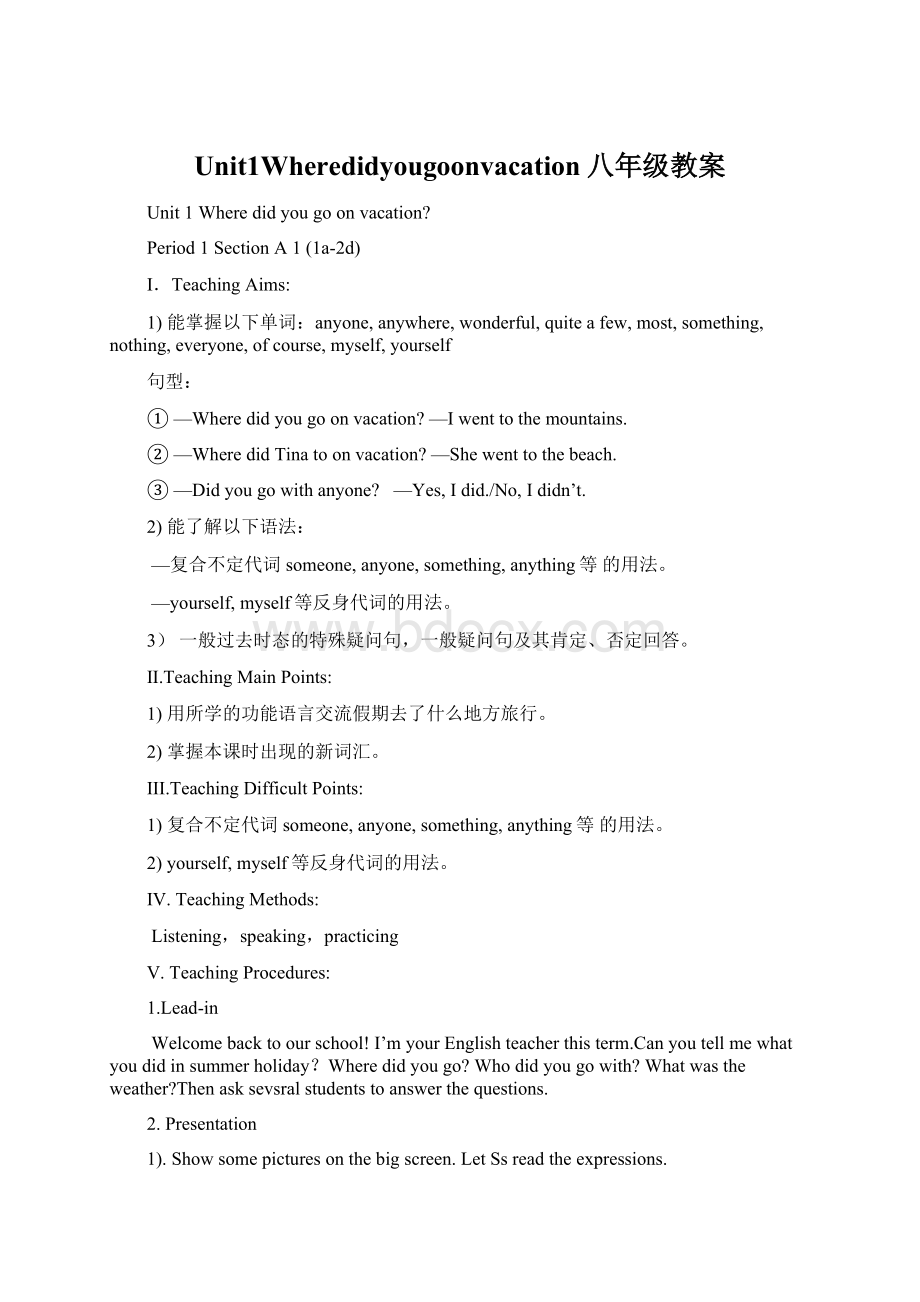Unit1Wheredidyougoonvacation八年级教案.docx
《Unit1Wheredidyougoonvacation八年级教案.docx》由会员分享,可在线阅读,更多相关《Unit1Wheredidyougoonvacation八年级教案.docx(17页珍藏版)》请在冰豆网上搜索。

Unit1Wheredidyougoonvacation八年级教案
Unit1Wheredidyougoonvacation?
Period1SectionA1(1a-2d)
I.TeachingAims:
1)能掌握以下单词:
anyone,anywhere,wonderful,quiteafew,most,something,nothing,everyone,ofcourse,myself,yourself
句型:
①—Wheredidyougoonvacation?
—Iwenttothemountains.
②—WheredidTinatoonvacation?
—Shewenttothebeach.
③—Didyougowithanyone?
—Yes,Idid./No,Ididn’t.
2)能了解以下语法:
—复合不定代词someone,anyone,something,anything等的用法。
—yourself,myself等反身代词的用法。
3)一般过去时态的特殊疑问句,一般疑问句及其肯定、否定回答。
Ⅱ.TeachingMainPoints:
1)用所学的功能语言交流假期去了什么地方旅行。
2)掌握本课时出现的新词汇。
III.TeachingDifficultPoints:
1)复合不定代词someone,anyone,something,anything等的用法。
2)yourself,myself等反身代词的用法。
IV.TeachingMethods:
Listening,speaking,practicing
V.TeachingProcedures:
1.Lead-in
Welcomebacktoourschool!
I’myour English teacherthisterm.Canyoutellmewhatyoudidinsummerholiday?
Wheredidyougo?
Whodidyougowith?
Whatwastheweather?
Thenasksevsralstudentstoanswerthequestions.
2.Presentation
1).Showsomepicturesonthebigscreen.LetSsreadtheexpressions.
2).Focusattentiononthepicture.
Ask:
Whatcanyousee?
Say:
Eachpictureshowssomethingapersondidinthepast.Nameeachactivityandaskstudentstorepeat:
Stayedathome,Wenttomountains,wenttoNewYorkCity,Wenttothebeach,
visitedmyuncle,visitedmuseums,wenttosummercamp
3).Now,pleasematcheachphrasewithoneofthepicturesnexttothenameofthe
activity,pointtothesampleanswer.
4).Checktheanswers.Answers:
1.f2.b3.g4.e5.c6.a7.d
3.Listening
1.Pointtothepictureonthescreen.
Say:
LookatthepictureA.WheredidTinagoonvacation?
Shewenttomountains.
Ask:
Whatdidthepersondoineachpicture?
2.Playtherecordingthefirsttime.
3.Playtherecordingasecondtime.
Say:
Therearethreeconversations.Thepeopletalkaboutwhatdidonvacation.Listentotherecordingandwritenumbersofthenamesintherightboxesofthepicture.
4.Checktheanswers.
4.Pairwork
1.Pointoutthesampleconversation.AsktwoSstoreadtheconversationtotheclass.
2.Nowworkwithapartner.Makeyourownconversationaboutthepeopleinthepicture.
3.Ssworkinpairs.Astheytalk,movearoundtheclassroomandgiveanyhelptheyneed.
4.Letsomepairsactouttheirconversations.
5.Listening
1).TellSstheywillhearaconversationaboutthreestudents’conversations.Listenforthefirsttimeandfillinthechart.ThenlistenagainandcheckYes,orNo.
2).LetSsreadthephrasesinthechartof2b.
3).Playtherecordingthefirsttime.Sslistenandfillinthechart.
4).PlaytherecordingasecondtimefortheSstocheck“Yes,Idid.”or“No,Ididn’t.”
5).ChecktheanswerswiththeSs.
6.Pairwork
1.LettwoSsreadtheconversationbetweenGrace,KevinandJulie.
2.LetSsworkinpairsandtrytorole-playtheconversation.
3.Asksomepairstoactouttheirconversations.
7.Role-play
1.FirstletSsreadtheconversationandmatchthepeopleandplacestheywent.
2.LetSsactouttheconversationsinpairs.
3.Someexplanationsin2d.
重点知识点:
1.不定代词anyone是不定代词,意为“任何人”,相当于anybody,主要用于疑问句或否定句中。
作主语时,谓语动词用单数。
Eg:
Hello!
Isanyoneathome?
喂!
有人在家吗?
Ididn’tseeanyoneintheroom。
我没看见有人在房间里。
Doyouknowanyoneelsewhowantsaticket?
你知道还有谁想要一张票吗?
类似的不定代词有:
someone(某人),somebody(某人),something(某事,某物),anyone(任何人),anybody(任何人),anything(任何事情),noone(没有人),nobody(没有人),nothing(没有什么,没有一件东西),everyone(每人;人人;所有人),everybody(每个人),everything(每件事,一切事物)
不定代词被其他词修饰时的位置:
形容词、动词不定式、介词短语、分词或从句修饰不定代词时,要放在不定代词之后。
Eg:
Don’tworryaboutme.Thereisnothingdifficultforme.
不要替我担心,什么都难不倒我。
Ihavesomethinginterestingtotellyou.
我有一些有趣的事情告诉你。
2.Wetookquiteafewphotosthere.我们在那里照了好多照片。
quite的用法:
quite为程度副词,可以修饰形容词、副词或动词,意为“很;非常”。
Eg:
HerEnglishisquiteperfect.她的英语好极了。
Sheplaysquitewell.她表演得挺不错的。
辨析:
quiteafew&quitealittle
Quiteafew意为“相当多,不少”,用于修饰可数名词。
Eg:
QuiteafewstudentscometovisitPekingUniversityeveryyear.
每年有很多学生参观北京大学。
Quitealittle意为“相当多;不少”,用于修饰不可数名词。
Eg:
Thereisquitealittlemeatinthefridge.
冰箱里有不少的肉。
Exercises:
1.lastsummervacation,we_____manyphotoswhenwehadatriptoDalian.
A.takeB.takesC.tookD.willtake
2.–Mum,I’mhungry.Isthere_____toeat?
A.somethingB.nothingC.anythingD.everything
3.Afteralongwalkinthesun,theywantedtodrink_______.
A.coldsomethingB.somethingcold
C.nothingcoldD.coldanything
4.DidLisatellyou______intheletter?
A.funnyanythingB.anythingfunny
C.funnysomethingD.somethingfunny
Homework:
用英语询问你的一位好朋友,她(他)假期去了哪里?
看到了什么?
并将此对话写在作业上。
A:
Wheredidyougo…?
B:
Iwentto…
A:
Didyousee…
B:
Yes,Idid./No,Ididn’t.
Ⅵ.TheBlackboardDesign:
VII.Teachingreflection:
Unit1Wheredidyougoonvacation?
Period3SectionB11a-2e
一、教学目标:
1.语言知识目标:
1)能掌握以下单词:
decide,try,paragliding,feellike,bird,bicycle,building,trader,wonder,difference,top,wait,umbrella,wet,becauseof,below,enough,hung
ry
2)能掌握以下句型:
①Wheredid…?
②Whatdid…?
③Howwas…?
/Howwere…?
④Didshe/he…?
2.情感态度价值观目标:
学生了解我国不同地方的人们上学的方式,了解还有一些贫困地区的孩子们需要我们去帮助他们。
二、教学重难点
1.教学重点:
1)掌握本课时出现的生词及表达方式。
2)进行听力训练,提高综合听说能力。
3)阅读短文,获得相关信息,提高学生们的综合阅读能力。
2.教学难点
1.听力训练
2.阅读2b部分的短文并完成相关要求。
三、教学过程
Ⅰ.Warming-upandrevision
1.Dailygreeting.
2.Checkthehomework.LetsomeSsreportwheredidtheygoonvacation.
3.Reviewthe“复合不定代词”
4.Reviewthe“反身代词”
5.Showamovieofparagliding.
Ⅱ.Writing
Workon1a:
1.Pointtothesixwords.delicious,expensive,exciting,cheap,terrible,boring
2.ReadthewordsandletSsreadaftertheteacher.
3.Pointtothelastpictureandsay:
Thisisacake.It’sdelicious.Thendothesamethingforallsixpictures.
4.LetSsmatcheachwordwithapicture.Thenchecktheanswerswiththestudents.
Workon1b:
1.Explainthemeaningof“words”and“words.”
2
.LetSsdiscussthewordstheyknowandwritethemdownontheline.
3.LetsomeSsreadouttheirwordstotheclass.(OrletsomeSswritetheirwordsontheblackboards.)
Ⅲ.Listening
Workon1c:
1.T:
Nowlet'sworkon1c.First,letonestudentreadthequestionsaloud.MakesurealltheSsknowthemeaningsofthequestions.
2.Playtherecordingforthefirsttime.Ssonlylisten.
3.Thenplaytherecordingforthesecondtime.Ssl
istenandanswerthequestions.
4.ThenplaytherecordingforthethirdtimefortheSstochecktheanswers.
5.Sslistentothetapeandcirclethewordsandphrasestheyhear.
6.Checktheanswers:
(Lookatthebigscreen.)
Workon1d:
1.TellSsthistimetheyhavetowritedownwhatLisasaidabouthervacation,thepeople,thefunpark,thefoodandthestore.
2.Thenplaytherecordingforthesecondtime.Sslistenandwritedownthewords.
3.ThenplaytherecordingforthethirdtimefortheSstochecktheanswers.
听力指导:
在听时要抓重点内容。
第一次听要求我们回答问题,因此在听的时候,应重点将与这些问题相关的内容方面的听清,其他作为非重点内容。
另外,要注意要速记下重点内
容。
在完成1d部分时要注意听的重点是放在Lisa对这五个方面的事情所做评价,因此应听清楚那些形容词。
Ⅳ.Pairwork
1.TellSstoaskandansweraboutLisa’svacation.Beginyourquestionswiththefollowingsentences.Forexample:
Wheredidyougoonvacation?
IwenttoNewYorkCity.
Didyougowithanyone?
Yes,Idid.
2.SsworkinpairsandaskandansweraboutLisa’svacations.
3.Letsomepairscometothefrontandaskandanswerinpairs.
Ⅴ.Discussion
1.TellSstoworkingroups.Discussthequestionstogether.
Whatdopeopleusuallydoonvacation?
Whatactivitiesdoyoufindenjoyable?
2.GiveSssomepossibleanswers:
Peopleusuallygotosomeplacesofinterestforvacation.
Ifindfishingenjoyable.
3.Ssdiscussthetwoquestions.Writedowntheiranswers.Letsomegroupreporttheiranswers.
VI.Reading
Workon2b:
1.T:
Nowwe’llreadJane’sdiaryentriesabouthervacationandanswerthequestions.
DidJanehaveagoodtimeonMonday?
WhataboutonTuesday?
2.Ssreadthediaryquicklyandfindtheanswerstothequestions.
3.ChecktheanswerswiththeSs.
Workon2c:
1.LetsomeSsreadJane’sdiaryentriesagain.Fillinthechart.
2.LetSslookatthechartfirst.Thenletthemreadandfillinthechart.
3.Checktheanswers.(Lookatthebigscreen.)
Workon2d:
1.TellSstheyshouldreadtheconversationaboutJane’striptoPenangagainandusetheinformationinthediaryentries.
2.SsreadtheconversationaboutJane’striptoPenangfirstthentrytofillintheblanks.
3.方法指导:
首先,应读通读整个对话一遍,理解对话的大意;然后,认真阅读有空格的上下句的内容,结合日记的内容,确定空格处的内容。
最后,再通读一遍对话,综合日记的内容看每个空格处是否贴切。
3.Ssreadcarefullyandtrytowritedownthewordsintheblanks.
4.Checktheanswerswiththeclass.
Workon2e:
1.告诉学生们这篇日记是Jane在七月十八日又一次参观了PenangHill后,所写的。
读日记,并用括号中单词的正确形式填空。
2.方法指导:
首先,再次明确这是一篇日记,因此应用一般过去时态;然后,通读一遍日记的内容,了解大体内容;最后,综合每句的内容,用括号中动词的正确的形式填空。
3.Ssreadthediaryandtrytofillintheblanks.
4.Checktheanswers.(Lookatthebigscreen)
5.对动词一般过去时的规则形式与不规则形式,再复习一遍。
Homework
用所给动词的适当形式填空。
1.Mymother______(buy)anewschoolbagformeyesterday.
2.When_____you_____(start)tolearnEnglish?
3.Myaunt______(take)ustodinneratarestaurantbutthefood_______(is)notgoodatall.
4.WhenI_______(am)inAmerica,I_______(make)alotofnewfriends.
5.They_______(have)agreatsalelastweekend.
板书设计:
教学反思
Unit1Wheredidyougoonvacation?
Period4SectionB23a-Selfcheck
一、教学目标:
1.语言知识目标:
1)复习询问或谈论假期去某地旅行的经历。
2)能够综合运动词的一般过去时形式,并能正确填空。
3)总结回顾动词过去式的规则变化不规则变化。
2.情感态度价值观目标:
1)学生了解我国不同地方的人们上学的方式,了解还有一些贫困地区的孩子们需要我们去帮助他们。
2)
通过谈论假期旅行的经历,明白在旅行时应注意保护环境。
二、教学重难点
1.教学重点:
1)能综合运用所的重难点词汇来完成相关任务。
2)能运用英语根据相关提示来记自己某次旅行